The 3-2-5 formation has become increasingly popular for its ability to overload central areas, stretch defenses horizontally, and create numerous attacking options in modern football. However, teams that understand its weaknesses can counter it effectively with the right defensive organization. In this article, we break down several tactical systems and strategies designed to neutralize the 3-2-5’s threat.
Understanding the Threat of the 3-2-5
Before exploring defensive strategies, it’s crucial to understand why the 3-2-5 poses such a challenge for opponents.
Numerical Overloads in Midfield and Attack – The 3-2-5 has four players operating in midfield: two central midfielders and two interior attacking midfielders. This often creates 4v3 or even 4v2 situations against a traditional midfield block, allowing the team to dominate possession and progress the ball efficiently. Meanwhile, the front five attackers can generate 3v2 or 4v3 situations against defensive lines, especially in the half-spaces between defenders.
Horizontal Stretching – The wide attackers/wing-backs occupy the full width of the pitch. This forces defenders to cover long lateral distances, stretching defensive lines and creating gaps that can be exploited through switches of play or diagonal passes.
Diagonal Progression – The midfielders behind the front five are constantly available for vertical or diagonal passes. This enables quick progression into advanced zones and allows for combination plays between midfielders and forwards, making it difficult for defenders to predict or intercept passes.
Compact Central Access – The design of the 3-2-5 ensures multiple players can receive the ball between the lines. This not only supports attacking rotations but also makes pressing risky, as defenders leaving their positions to close one player can create openings elsewhere.
Defending against the 3-2-5 requires careful planning. Teams must stay disciplined, maintain compactness both vertically and horizontally, and have clear strategies for controlling central overloads while managing wide threats.
1. 5-2-3: Man-to-Man Pressure
The 5-2-3 is one of the most direct answers to the 3-2-5 because it offers numerical equality across the pitch. With five defenders against the opposition’s front five and two midfielders against their double pivot, the structure ensures that no line is left outnumbered. In theory, this prevents the overloads that make the 3-2-5 so dangerous.
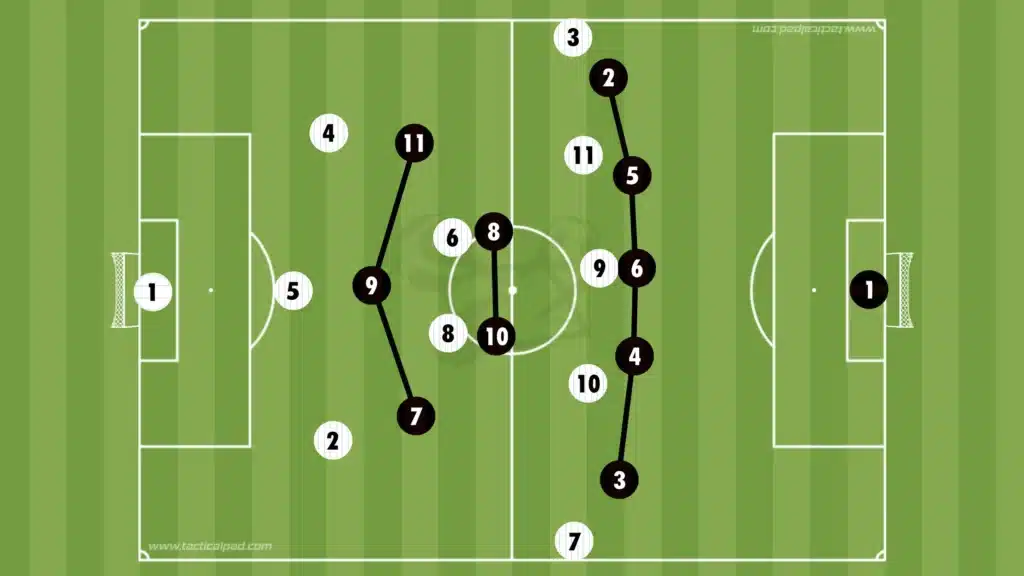
Numerical Equality Across the Pitch
Each player is matched directly against an opponent, reducing the risk of being exposed to numerical inferiorities in central or wide zones. The wing-backs can track the opposition’s wide attackers, the three center-backs deal with the attacking midfielders and central striker, and the two central midfielders stay tight on the double pivot. This equality allows the front three to press aggressively without fear that midfield or defensive lines will be overloaded.
The wingers play a particularly important role. They often start slightly deeper, closer to the central midfielders, providing balance when the ball is in central zones. However, when an opposition wide center-back carries the ball forward, it becomes the winger’s responsibility to step up and apply pressure, preventing unchallenged progression.
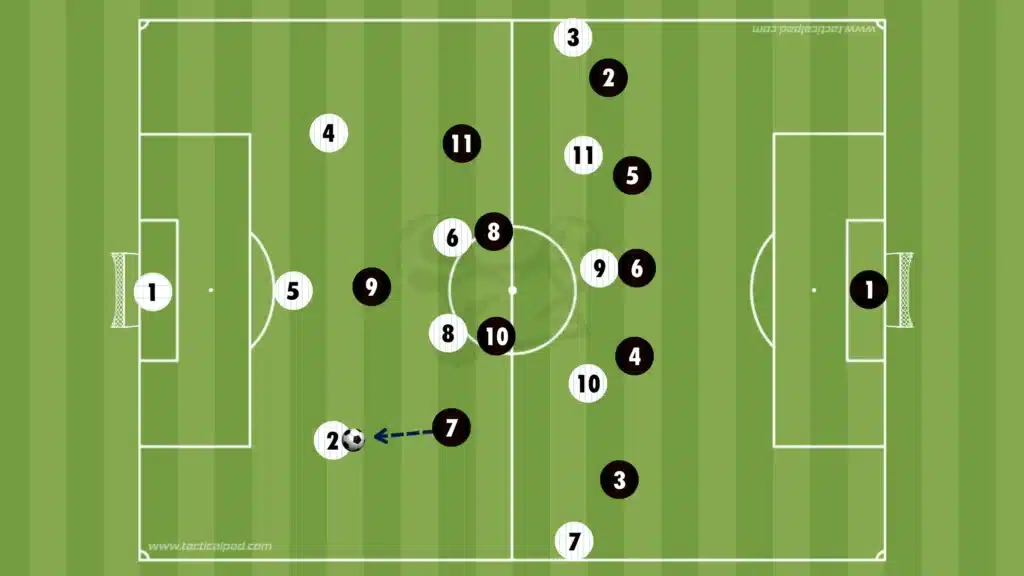
The Role of Distance-Markings
A crucial aspect of the 5-2-3 man-to-man approach is distance-marking. Not all opponents require tight marking at all times. If an attacker is far from the ball and unlikely to be immediately involved, the defender marking them can afford to leave extra space and instead provide cover or reduce dangerous passing lanes.
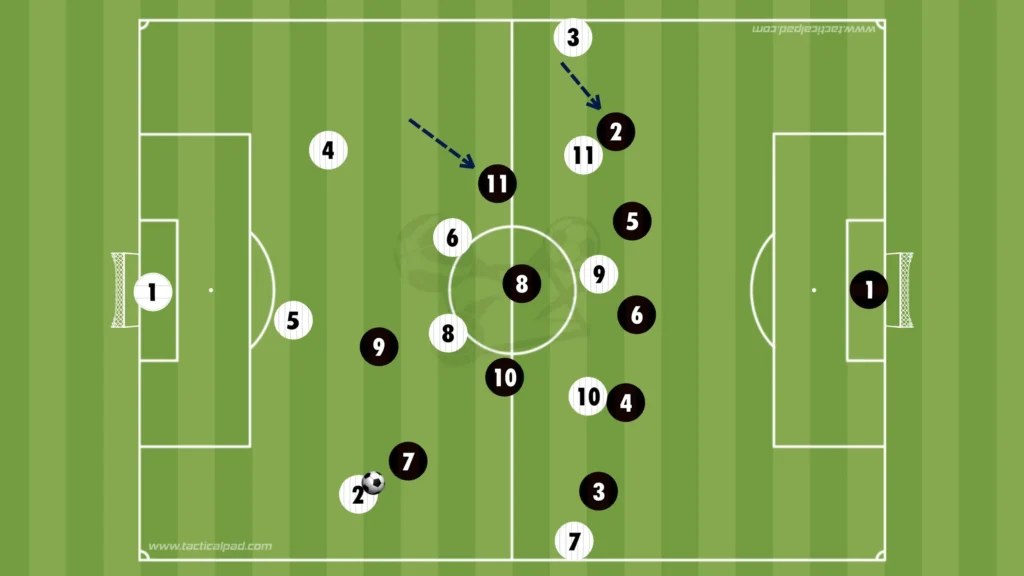
The closer a player is to the ball, the tighter their marking should be. Conversely, the further they are from the action, the more the defender can prioritize team balance over strict man-orientation. This principle allows defenders to give help in overloaded areas without abandoning their direct responsibility. Properly executed, distance-marking transforms the 5-2-3 from a rigid man-to-man system into a more flexible and dynamic defensive strategy.
The Dangers of the 5-2-3 Man-to-Man System
While offering equality, the system carries inherent risks:
Vulnerability to Rotations
Well-drilled attacking units thrive against man-to-man systems through positional rotations. For example, if an attacking midfielder drops deep while a holding midfielder pushes forward, defenders may be dragged out of position, opening lanes for runners to exploit.
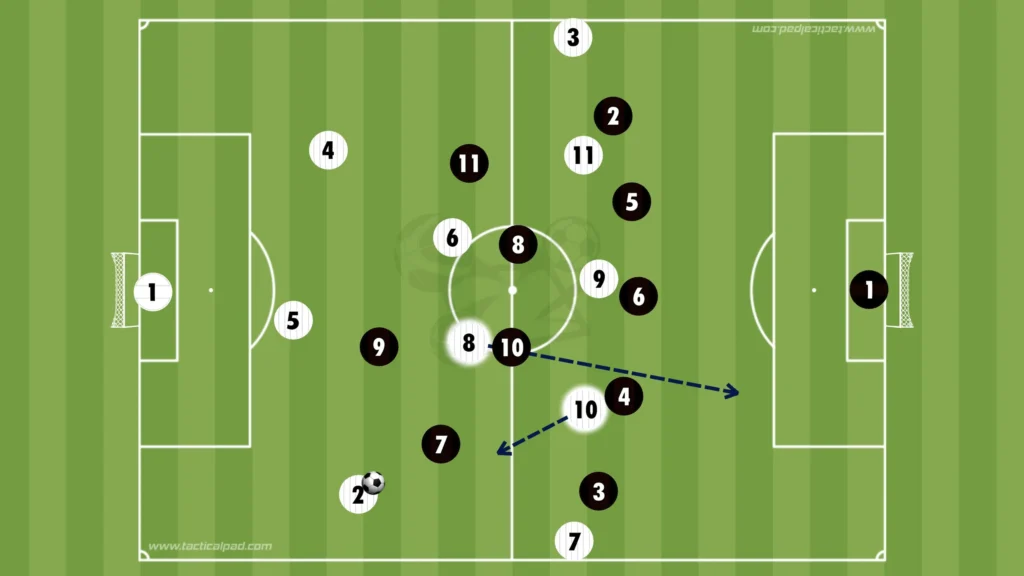
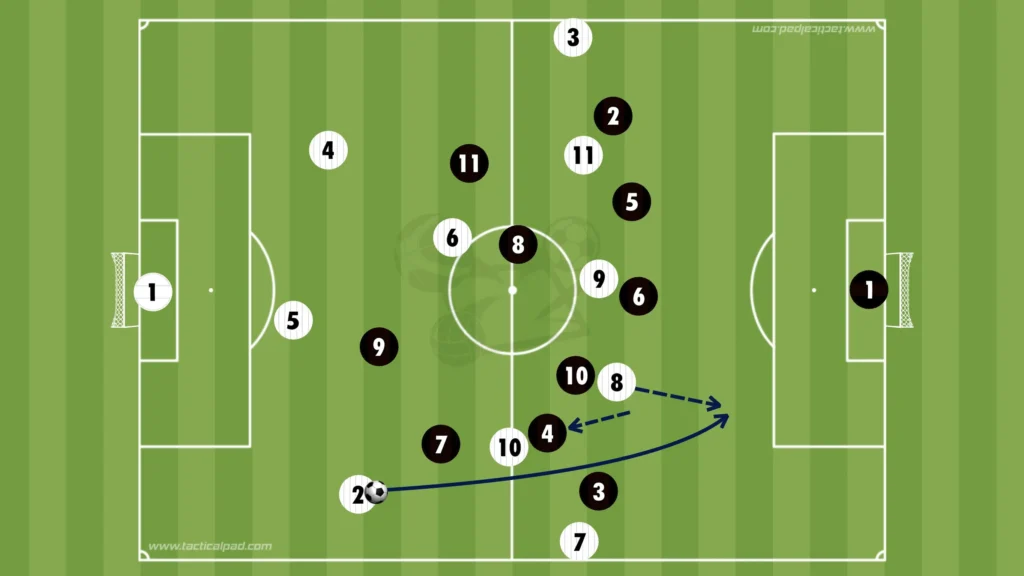
Collapsing Defensive Structure
Man-to-man defending relies on each duel being won. If one player is beaten, there is little natural cover, and the entire defensive line can unravel. Distance-marking helps mitigate this issue by providing secondary support, but the risk never disappears.
High Physical and Mental Demand
Tracking opponents across the pitch requires elite concentration and stamina. Any lapse, whether through fatigue or lack of awareness, can instantly break the structure and lead to goal-scoring chances.
Summary
The 5-2-3 offers the clearest structural answer to the 3-2-5, neutralizing many of its numerical advantages. However, its effectiveness depends heavily on the discipline, concentration, and physical capacity of the players. Distance-marking principles are essential to provide cover and avoid collapses, but against elite teams with fluid rotations, the risk of being exposed remains high.
2. 5-3-2: Compact Mid-block and Forcing Wide
The 5-3-2 offers a more compact, zonal response to the 3-2-5. Rather than matching opponents man-to-man, the aim is to close central spaces and force the opposition wide, where attacking moves are easier to defend.
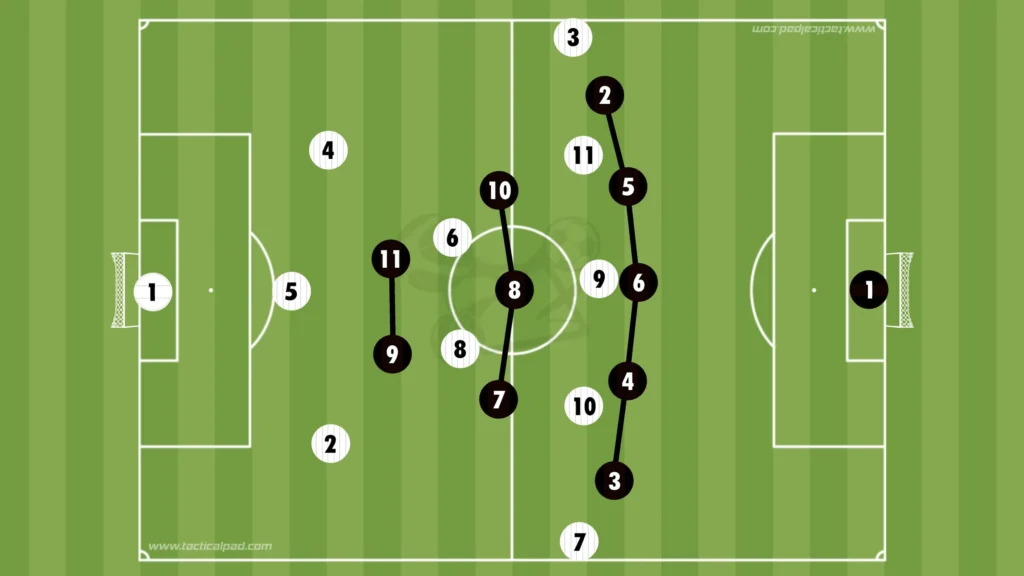
Compactness as the Core Principle
The back five naturally matches the opponent’s front five, ensuring numerical balance in the defensive line. The three central midfielders form a tight triangle in front of them, closing access into the half-spaces and central zones. The two strikers remain narrow, screening central passing lanes and discouraging direct play into midfield. This compactness prevents the opposition from exploiting the dangerous central areas where the 3-2-5 usually thrives.
Managing the Opposition Backline
One of the main challenges is that the forward line is outnumbered. The opposition’s three center-backs face only two strikers, creating a 3v2 advantage in the first phase of build-up. This allows the ball to circulate until a free wide center-back emerges.
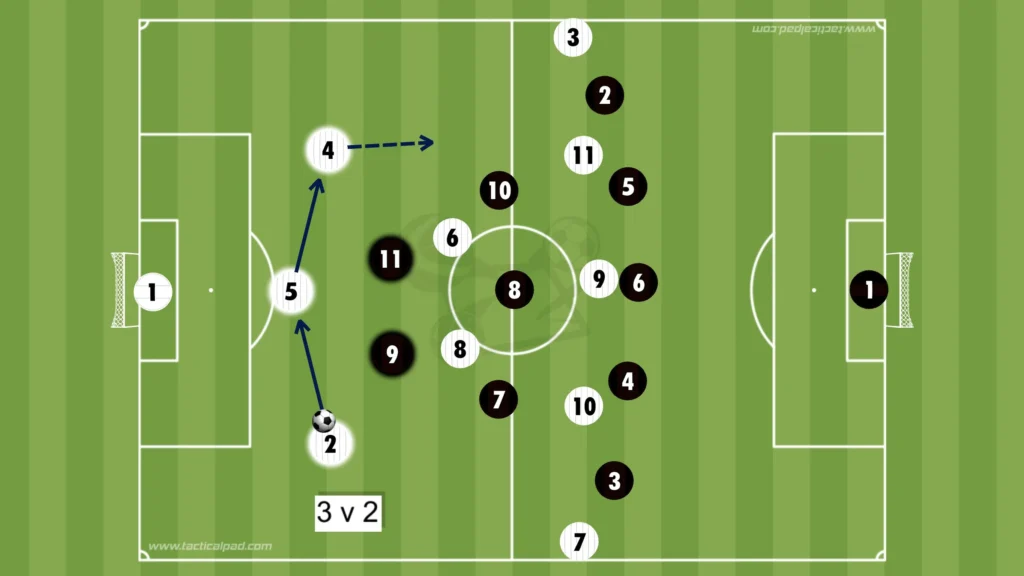
When this happens, the responsibility falls on the nearest wide central midfielder to push forward and close the advancing center-back. Their task is to stop him from carrying the ball uncontested into midfield. This adjustment keeps pressure on the ball, but it comes with a potential trade-off: as the midfielder steps out, space can open behind him.
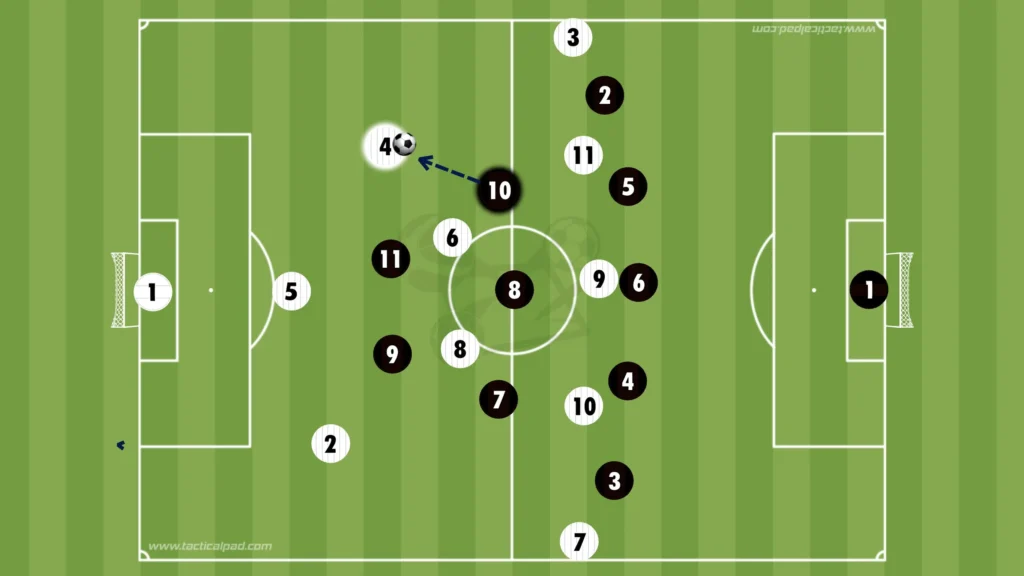
The Importance of Midfield Shifts
To maintain compactness, the other midfielders must react immediately when one player steps out. If the right central midfielder pushes up to engage, the central and left midfielders must shuffle across to cover the vacated space. This synchronized shifting ensures the block stays connected, avoiding gaps that can be exploited by quick diagonal passes or rotations from the opposition’s double pivot and attacking midfielders.
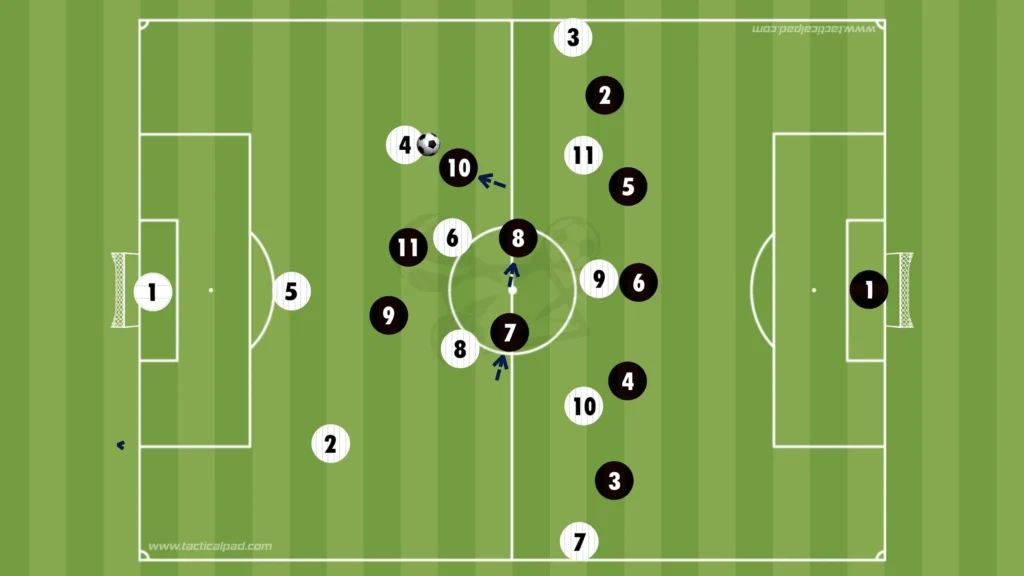
Strengths and Weaknesses of the 5-3-2
The 5-3-2’s main strength lies in zonal compactness. It closes the central corridor, forces the ball wide, and provides strong coverage in front of the backline. Against a 3-2-5, this can funnel play into less dangerous zones, where wing-backs and wide center-backs can defend 1v1 more comfortably.
However, the weaknesses come from the numerical deficit in the first pressing line. If the midfield fails to support effectively, opposition center-backs may advance and draw midfielders out of position, destabilizing the block. Success with this system relies on excellent timing, communication, and discipline from the midfield trio.
Summary
The 5-3-2 compact block represents a pragmatic solution to the 3-2-5. It denies central access, maintains balance across the defensive line, and channels play wide. Yet, its effectiveness hinges on the midfield’s ability to shift as a unit, covering spaces whenever a central midfielder is forced to step out and engage.
3. 4-1-4-1: Midfield Press to Deny Central Progression
The 4-1-4-1 is a well-structured defensive system, but against the 3-2-5, it presents several challenges. Its strength lies in its midfield coverage and pressing options, yet it is vulnerable to overloads both in defense and in wide areas.
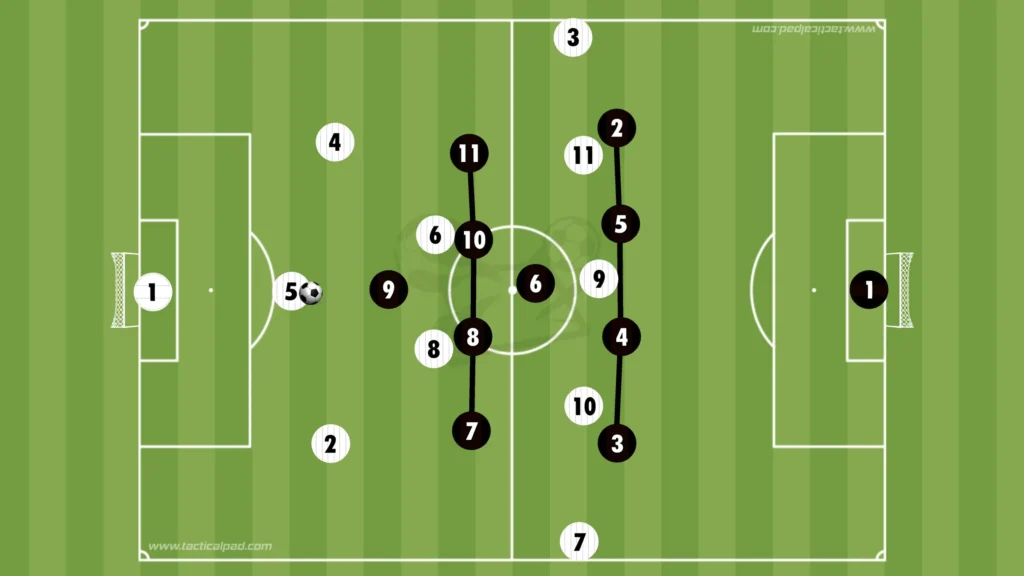
The Numerical Disadvantages
The biggest problem with the 4-1-4-1 against a 3-2-5 is numerical inferiority in key zones. Defensively, the back four face five attackers, often leaving fullbacks exposed in wide 1v2 situations.
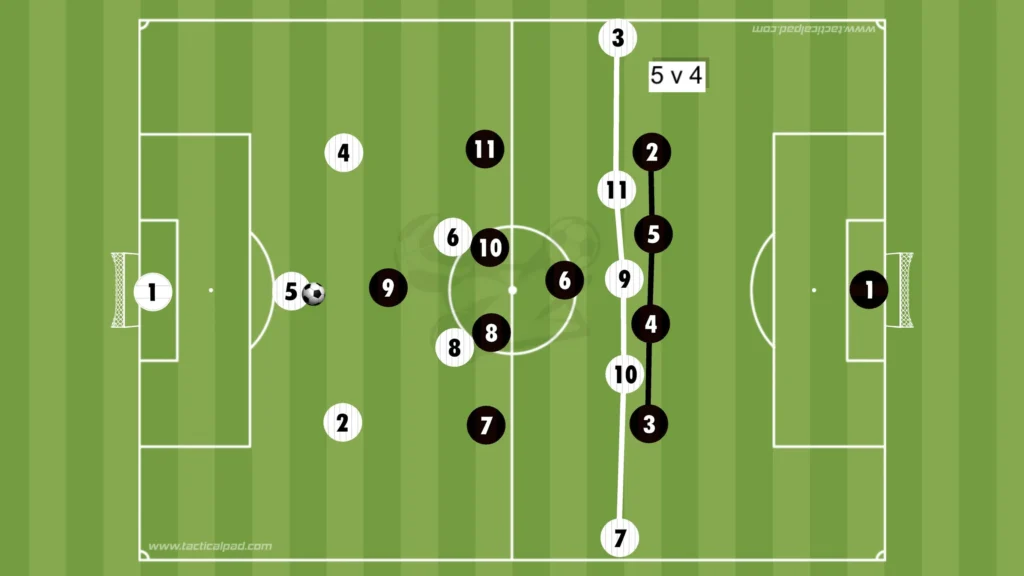
In midfield, the double pivot of the opposition plus their two attacking midfielders frequently create a 4v3 overload, especially when the attacking midfielders drop slightly between the lines. This makes it difficult to maintain central compactness without leaving gaps elsewhere.
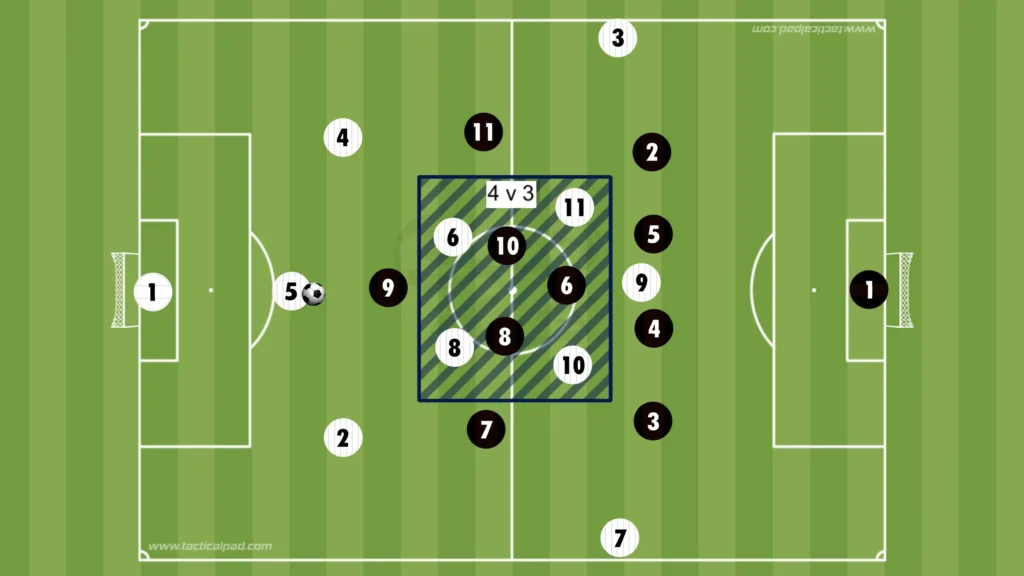
How the Midfield Functions
The two central midfielders in the line of four usually track the opposition’s pivots, which can successfully block vertical progression through the middle. However, once the ball is circulated to a wide center-back, the shape begins to stretch. The striker is left 1v3 against the opposition’s backline, meaning the ball can easily be worked to a free center-back.
When this happens, the responsibility falls on the wide midfielder to push up and confront the advancing wide center-back. But this creates a knock-on effect: the fullback is left 1v2 against the opposition winger and attacking midfielder in the half-space.
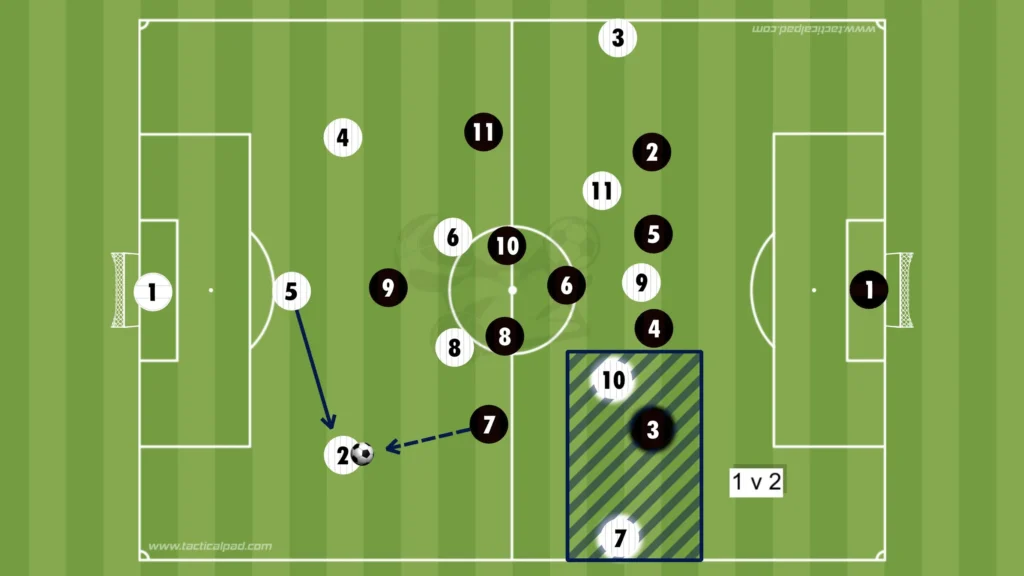
Covering the 1v2 Wide Scenarios
There are two main solutions:
Center-back support – The nearest central defender shifts wide to pick up the attacking midfielder, while the fullback takes the winger. This can stabilize the wide duel but opens a dangerous gap in the center, leaving the remaining center-back isolated in a 1v1 against the striker.
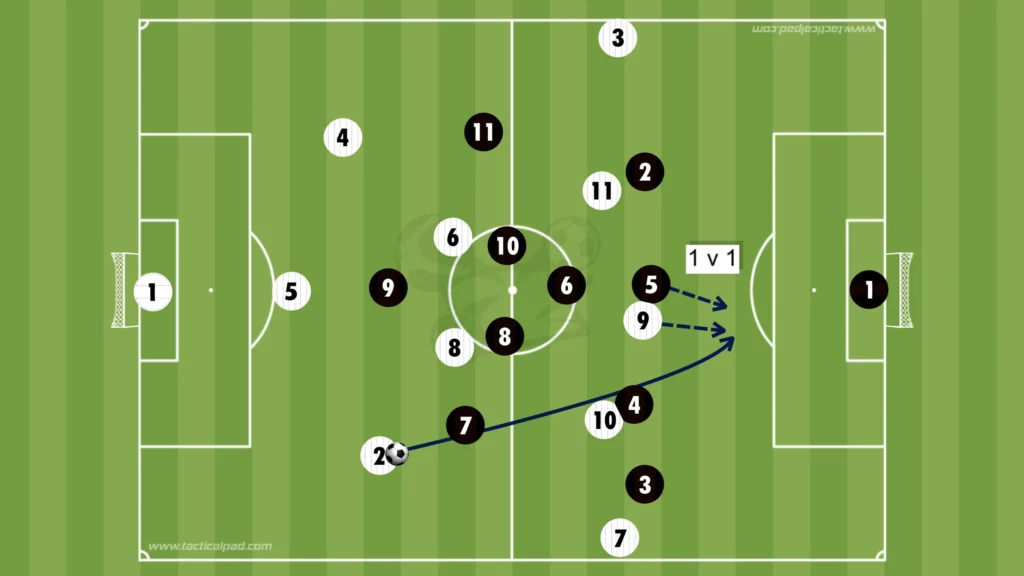
Holding midfielder cover – Alternatively, the holding midfielder slides across to mark the attacking midfielder, leaving the back four intact. This avoids exposing the central defenders but creates a new problem: when possession is recycled and switched quickly across the backline, the holding midfielder must sprint to cover the other side. Over 90 minutes, this is physically exhausting and difficult to sustain.
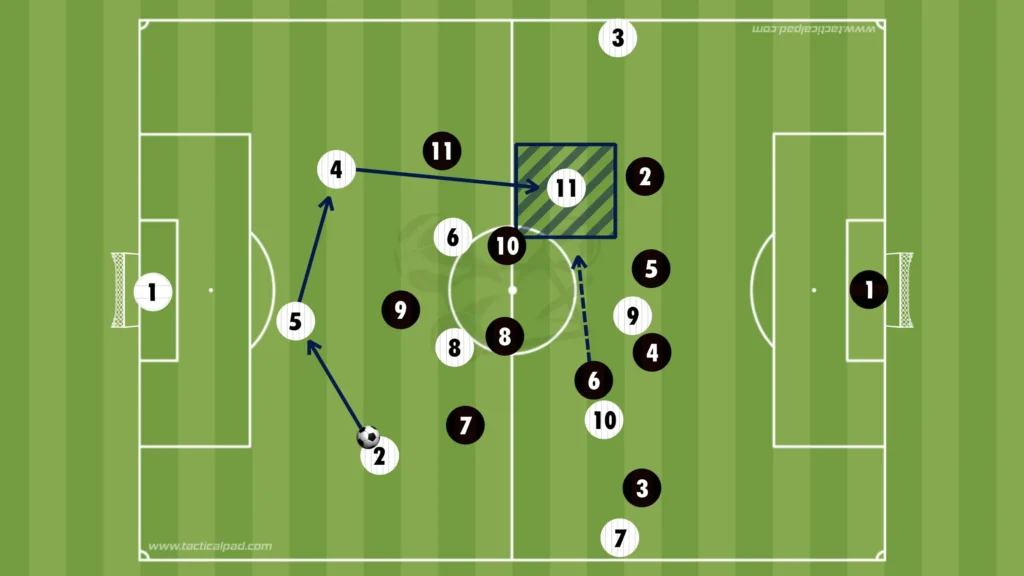
The Main Advantage
Despite its flaws, the 4-1-4-1 does provide one potential advantage. With two central midfielders pressing the opposition pivots, it can disrupt central progression. Additionally, the front three (striker and wide midfielders) can engage aggressively against the opponent’s three center-backs, allowing the team to press high and prevent clean build-up. In the right moments, this can force turnovers in advanced zones.
Summary
The 4-1-4-1 is not the most reliable solution against a 3-2-5 because of its structural disadvantages in wide areas and midfield overloads. While it allows for aggressive pressing against the backline and good access to opposition pivots, it often leaves defenders exposed in 1v2 situations or forces the holding midfielder into exhausting covering actions. Against teams that excel at switching play, this system becomes especially vulnerable.
4. 4-2-3-1: Targeting Key Threats
The 4-2-3-1 remains one of the most commonly used defensive systems in modern football, and it offers a strong balance of compactness and central coverage. However, against a 3-2-5, it faces structural challenges, particularly in terms of numerical disadvantages in both the backline and midfield.
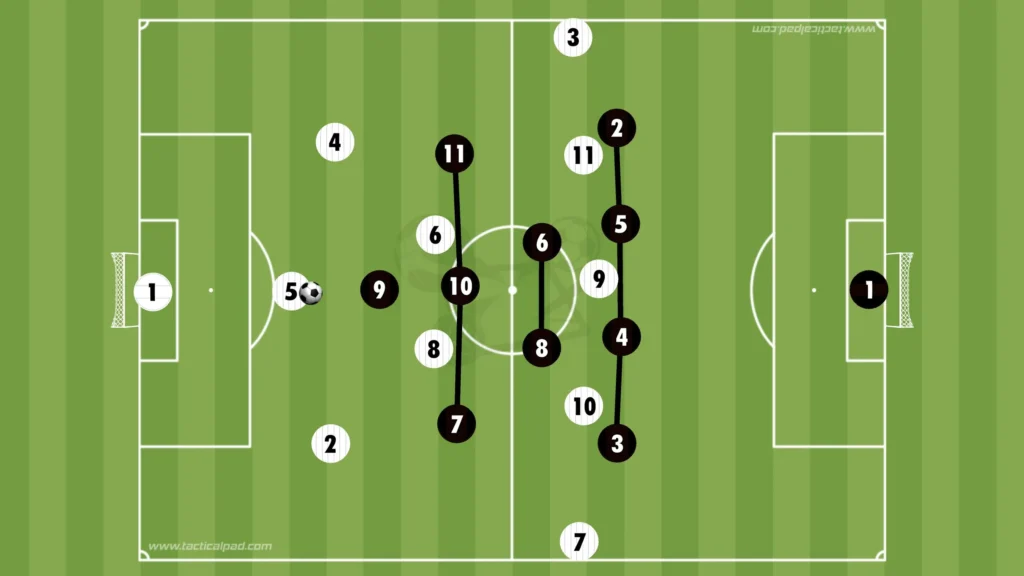
Compactness and Central Control
Like most defensive shapes, the 4-2-3-1 aims to close the middle of the pitch and protect central access. With two holding midfielders screening the defense, the team has good protection against direct passes into the opposition’s attacking midfielders.
Numerical Inferiorities
The main issue lies in numbers:
- Backline disadvantage – The four defenders face the opposition’s five attackers, leaving the fullbacks under consistent pressure in wide areas. However, this can often be solved by the holding midfielders dropping down slightly.
- Midfield disadvantage – The opposition’s four central midfielders (two pivots plus two attacking midfielders) create a 4v3 overload against the double pivot and the lone attacking midfielder.
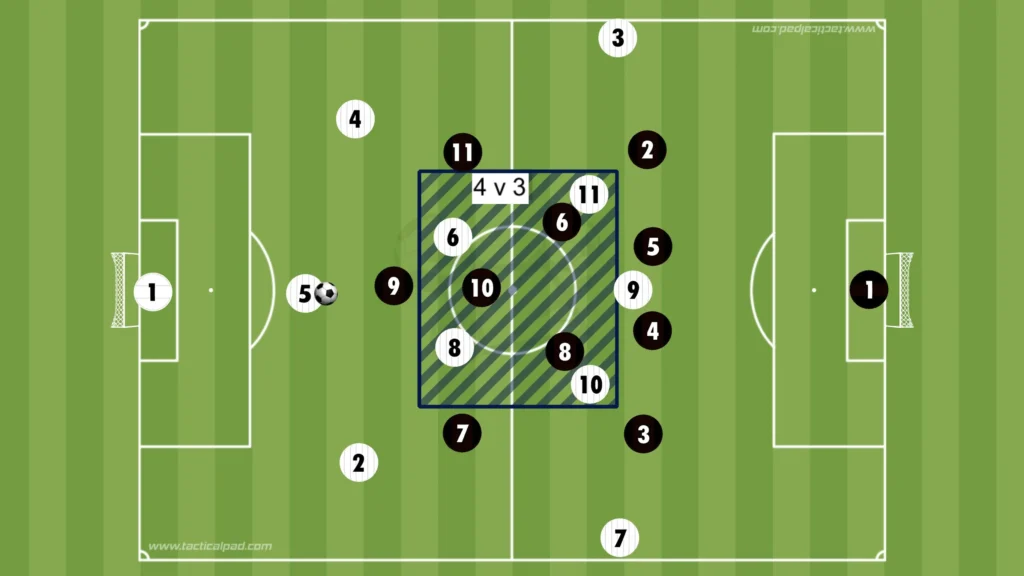
Role of the Attacking Midfielder
The key player in this system is the No. 10. He must stay between the opposition’s two pivots, maintaining balance rather than pressing aggressively. If one pivot receives the ball, he can step forward to block progression. If he presses one pivot too early or too hard, he risks leaving the other one completely open.
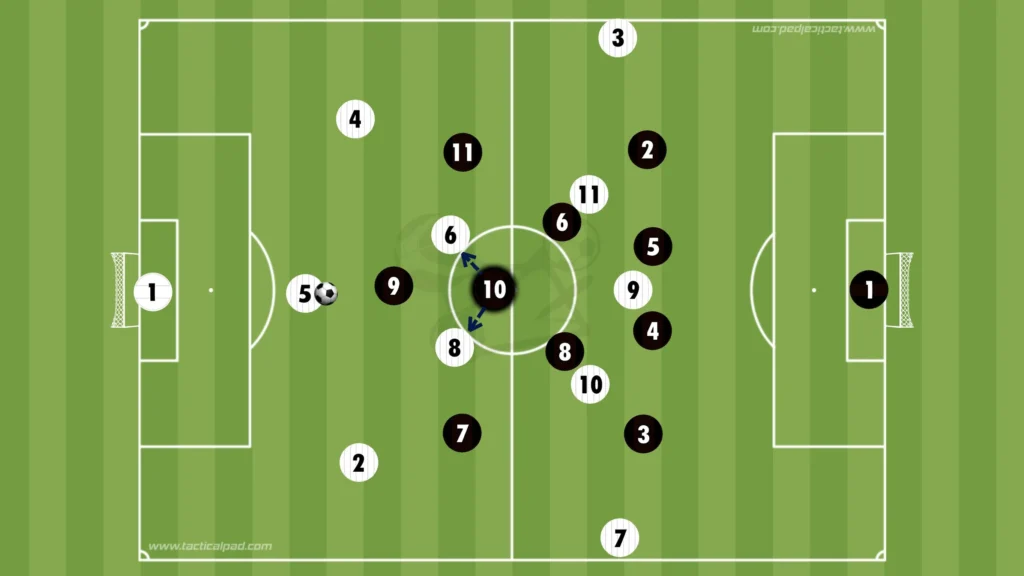
Pressing the Wide Center-Backs
When the ball shifts to one of the opposition’s wide center-backs, the near-side winger pushes up to apply pressure. Simultaneously, the attacking midfielder shifts across to cover the ball-side pivot. To prevent the far-side pivot from being completely free, the far-side winger tucks inside, staying compact and prepared to close him down if the ball switches.
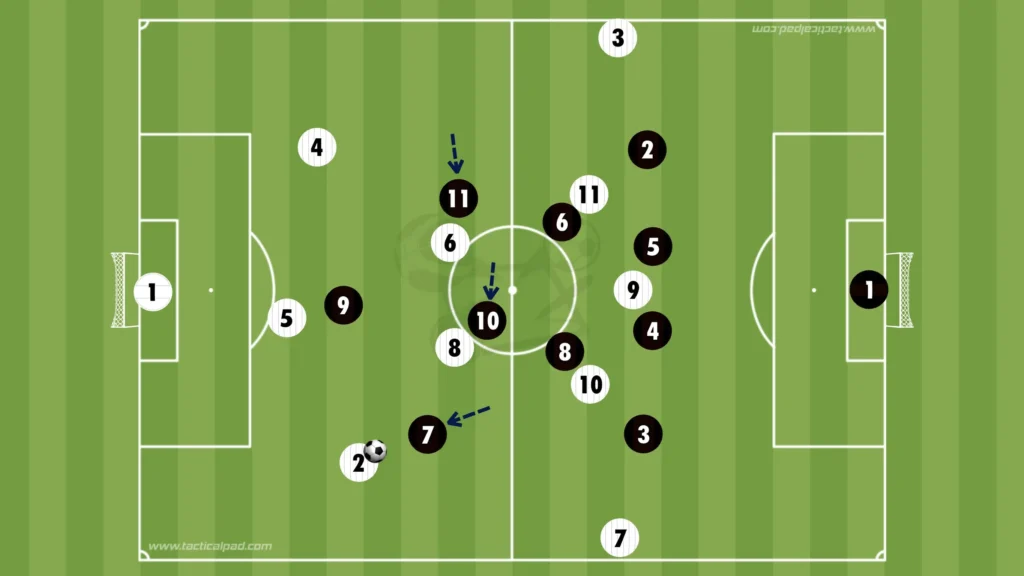
This scheme provides temporary balance, but it requires constant shifting across the pitch. If the ball is recycled quickly through the opposition backline to the far-side center-back, the entire midfield and forward line must shift across in unison:
- The attacking midfielder moves to the new ball-side pivot.
- The far-side winger, who had tucked inside, must now push outward to stop the wide center-back from advancing.
- The previous ball-side winger tucks in to cover the new far-side pivot.
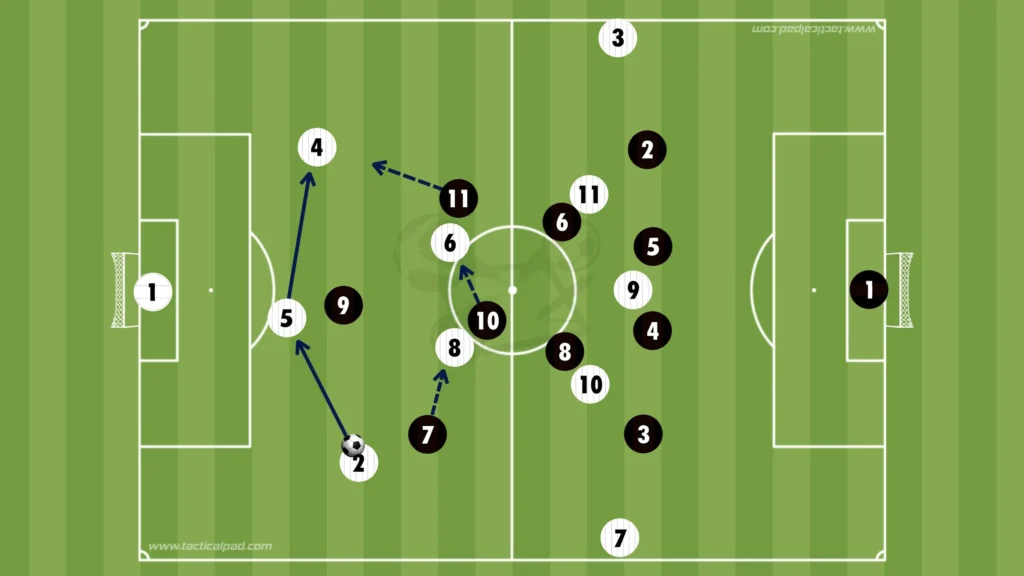
The Physical Challenge
This defensive shifting demands immense energy and discipline. If the movement is even slightly delayed, space opens up for either the pivots or the wide center-backs to progress the ball. Over 90 minutes, this constant lateral work can wear down wingers and attacking midfielders, leading to mistakes and openings for the opposition.
The Main Advantage
Despite its flaws, the 4-2-3-1 has a crucial strength: the double pivot can effectively deal with the opposition’s attacking midfielders. This means fullbacks can step wide to press wingers without leaving central defenders exposed to underlaps. Meanwhile, the center-backs remain focused centrally, maintaining a 2v1 advantage against the striker. This stability in the defensive core is the formation’s greatest asset when facing a 3-2-5.
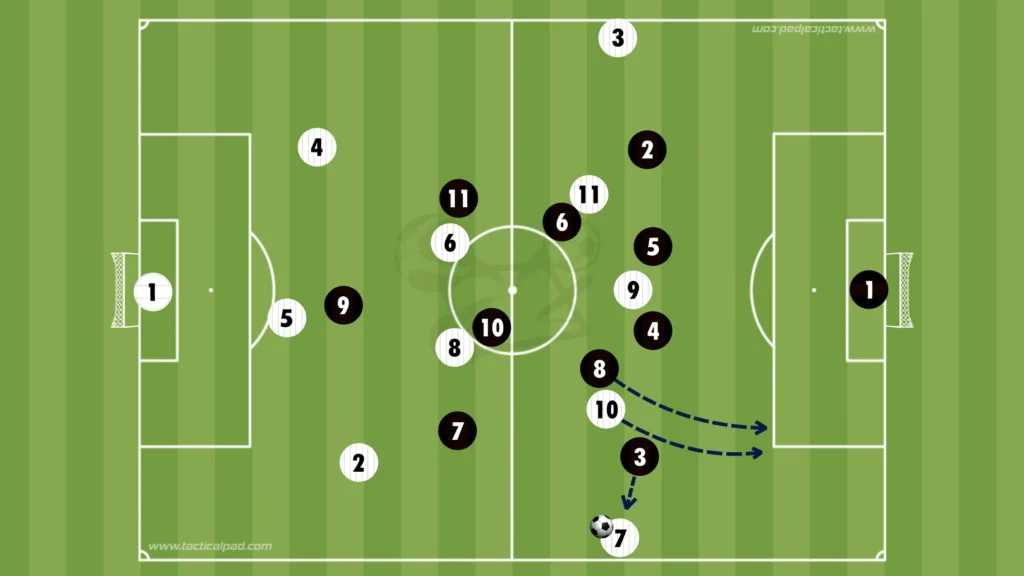
Summary
The 4-2-3-1 offers a structured and compact approach but struggles with numerical disadvantages and constant lateral shifting. While it protects the center and stabilizes the backline, it demands relentless discipline from wingers and the No. 10 to prevent overloads from wide center-backs and pivots.
5. 4-4-2: Zonal Midfield and Numerical Inferiorities
The 4-4-2 remains one of the most recognizable defensive structures in football. Its focus, like many compact systems, is on closing the center and protecting access through the middle. Against a 3-2-5, however, the structure encounters major numerical challenges and constant dilemmas in the wide areas.
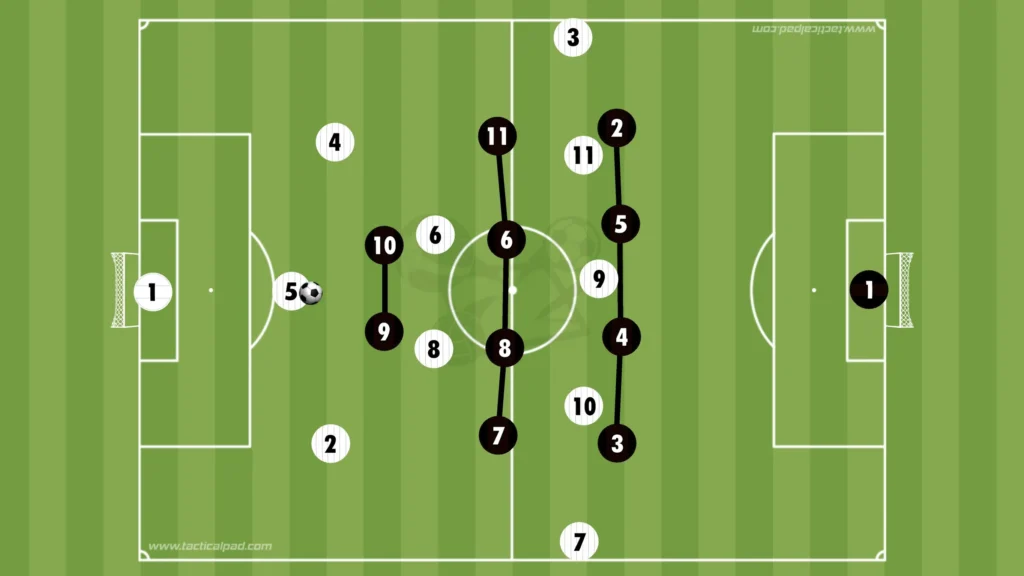
Compactness and Zonal Coverage
The 4-4-2 is naturally compact and primarily zonal. This makes it effective against fluid positional play and rotations, since players remain disciplined within their zones rather than being dragged out of position. In theory, this should slow down an opponent looking to overload central spaces.
However, the numerical disadvantages are clear:
- Backline – Four defenders against five attackers, leaving fullbacks vulnerable when both a winger and attacking midfielder occupy their side.
- Midfield – The two central midfielders are outnumbered 2v4 by the opposition’s double pivot and two attacking midfielders.
- Forward line – The two strikers press three opposition center-backs, meaning one is almost always free to carry the ball forward.
The Pressing Dilemma
If the two strikers step up to press the opposition’s three center-backs, they will be in a 2v3 numerical disadvantage. The press can win the ball occasionally, but more often one center-back will remain free, and the opposition can consistently access him to progress play.
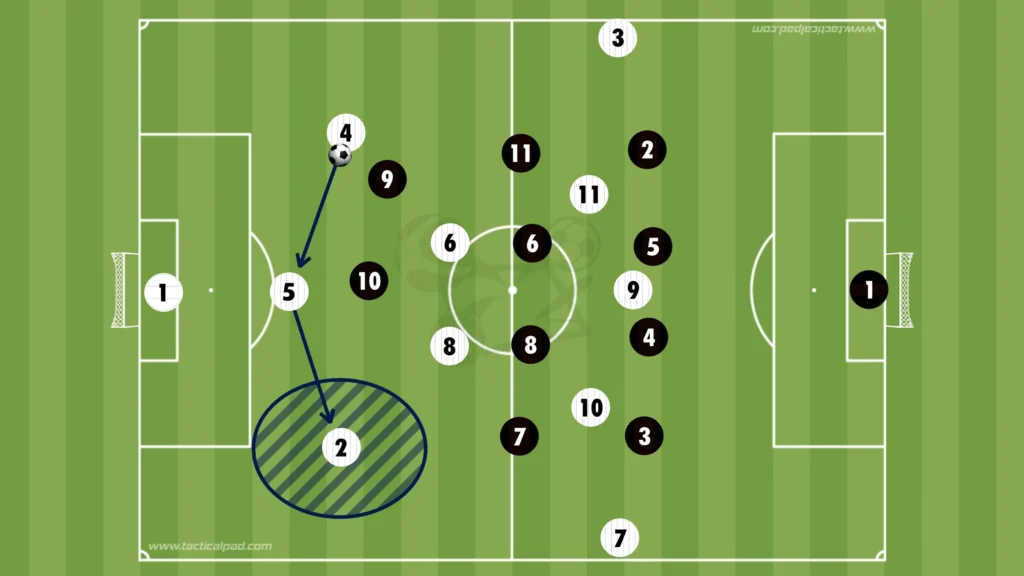
When the free player is a wide center-back, the near-side wide midfielder must step up to close him down.
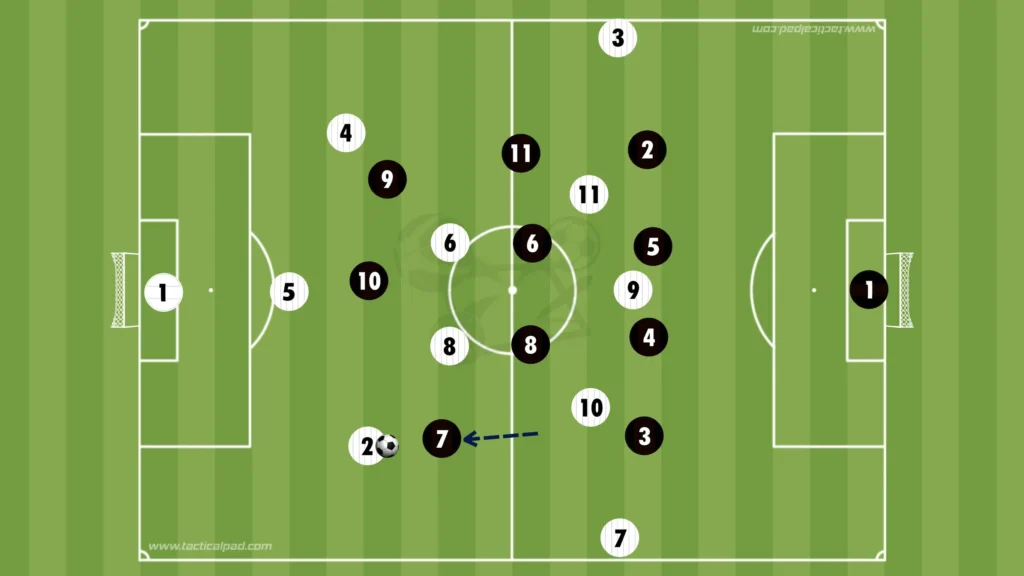
This sets off a chain of 1v2 situations, which creates dilemmas:
- Fullback’s dilemma – He must choose between stepping out to control the winger or staying tucked inside to track the attacking midfielder’s run. The player he leaves open will be able to receive the ball unopposed.
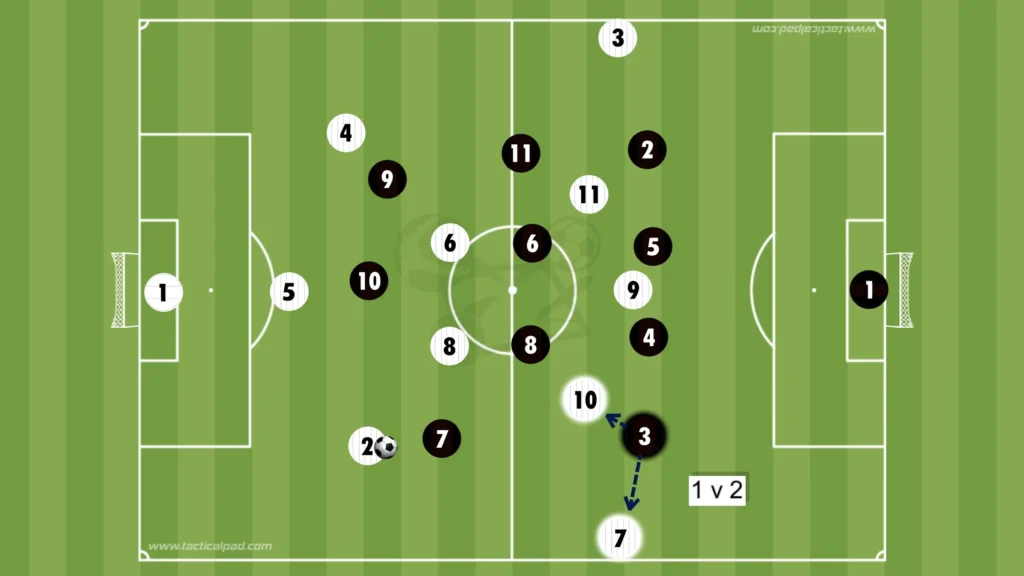
- Central midfielder’s dilemma – He must decide whether to drop deeper to cover the attacking midfielder or remain higher to screen the pivot. Once again, the player he leaves open will be able to receive the ball unopposed.
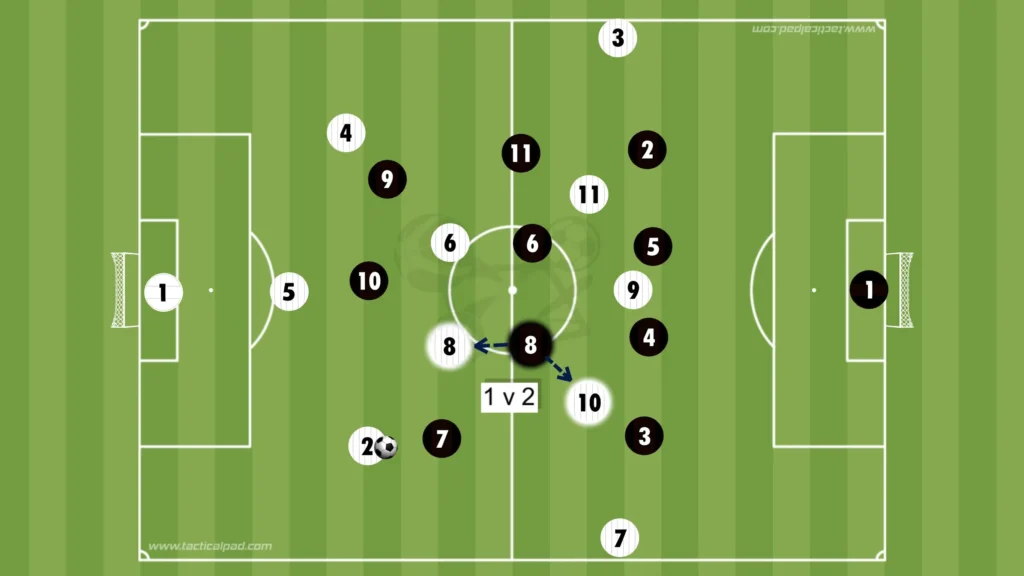
- Center-back’s dilemma – If a center-back shifts out to help, he leaves his partner in a dangerous 1v1 against the striker while opening gaps centrally.
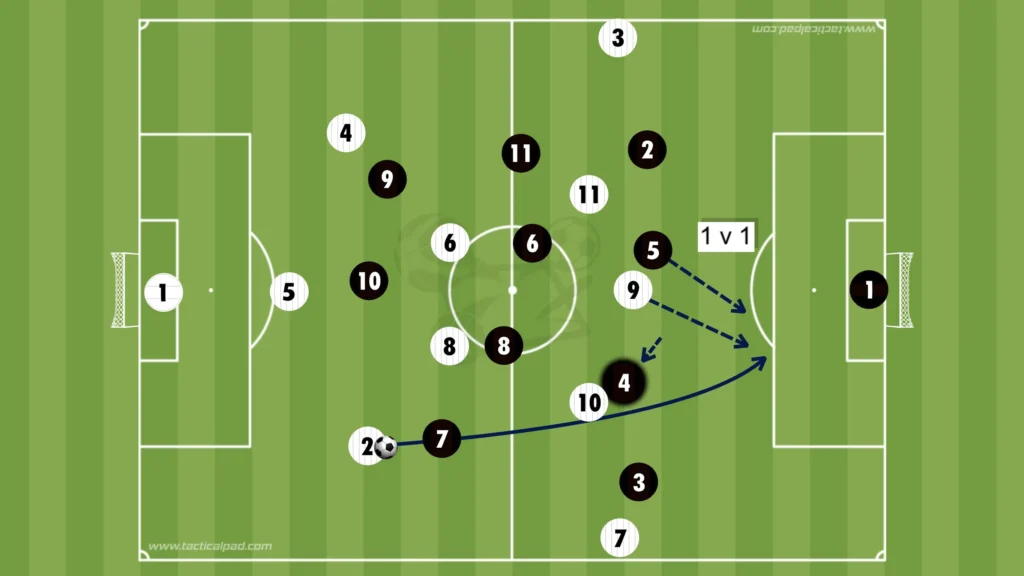
The “In-Between” Problem
These dilemmas often result in players becoming stuck between two opponents, hesitant to commit in one direction. This hesitation is fatal against a team with a high tempo of circulation. By moving the ball quickly, the opposition can consistently exploit whichever player is caught in-between, breaking lines and progressing the attack with relative ease.
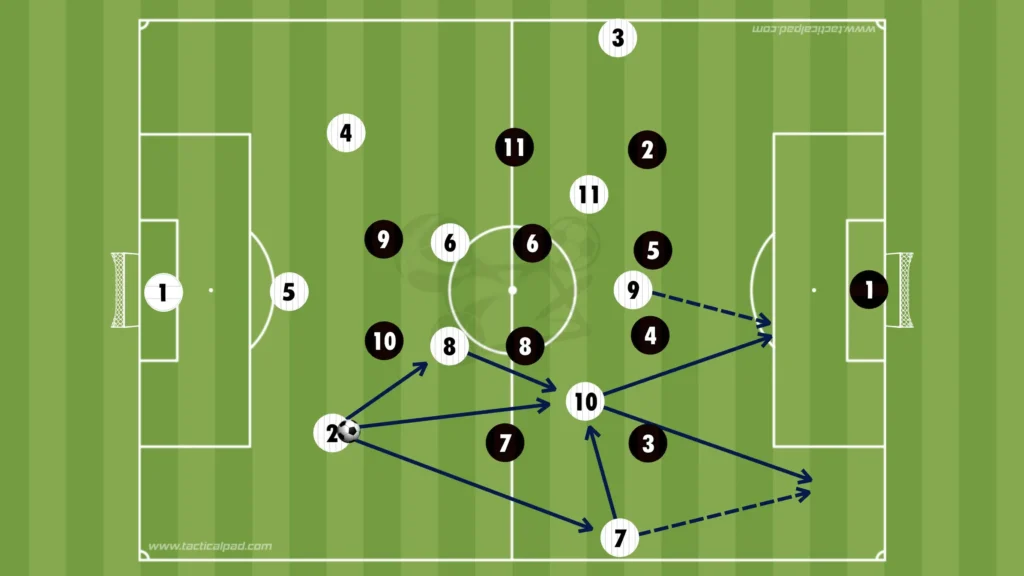
Structural Weaknesses
Because of these dilemmas, the 4-4-2 often feels stable at first glance — compact and difficult to break down. But as the opposition circulate possession, the lack of numerical balance in midfield and the backline means gaps eventually appear. Against well-drilled possession teams, the structure tends to crack under sustained pressure.
Summary
The 4-4-2 offers compactness and simplicity, but against a 3-2-5 it suffers from constant dilemmas and numerical inferiority. Wide midfielders, fullbacks, and central midfielders frequently find themselves caught between two opponents, and quick ball circulation exposes the weak points. While zonal discipline can stall rotations, the lack of balance makes it difficult to resist over 90 minutes.
6. 4-2-4: Winger Press and Denial of Build-Up (Our Favorite)
The 4-2-4 is perhaps the most effective and increasingly popular structure for defending against the 3-2-5. It combines compactness with an aggressive pressing scheme, forcing the opposition into predictable areas while keeping defensive integrity in wide and central zones.
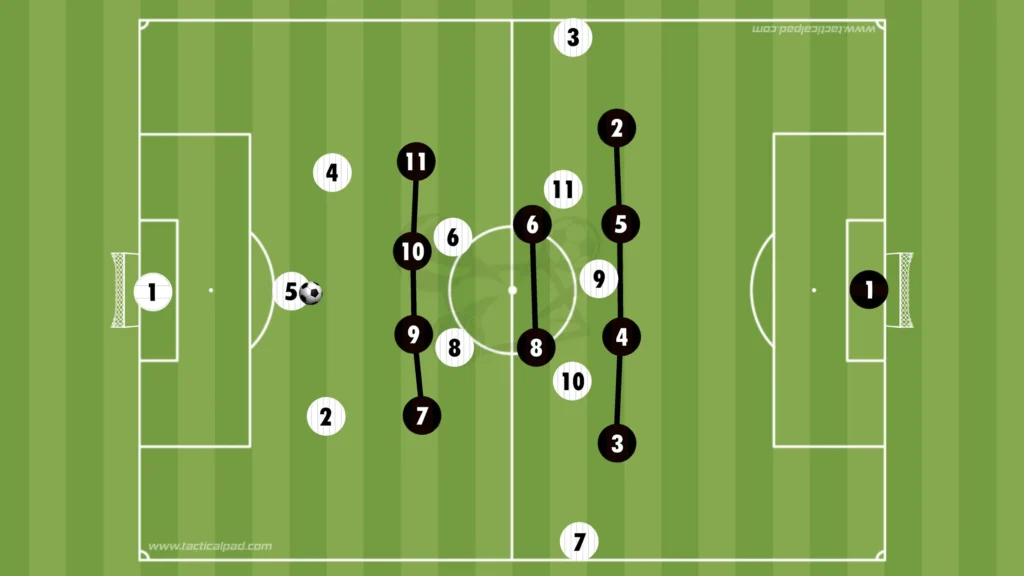
General Principles
The central concern remains the 2v4 numerical inferiority in midfield. The opposition’s double pivot plus two attacking midfielders can overwhelm a basic 4-2-4 if defended passively. To counter this, the strikers and holding midfielders must work as a unit:
- Strikers – Drop slightly deeper to keep the opposition pivots in their cover shadows.
- Holding Midfielders – Drop slightly to control the two attacking midfielders.
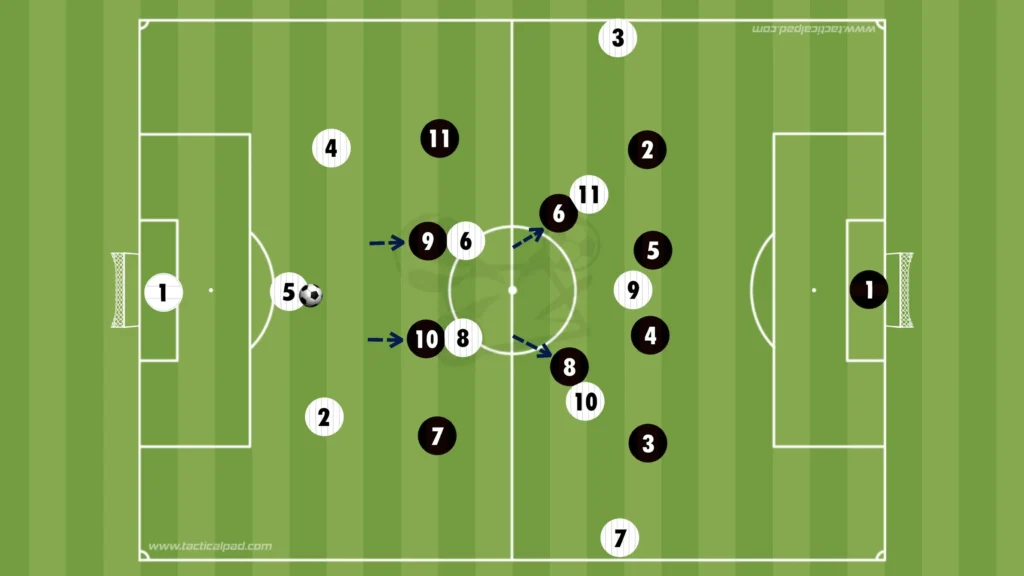
Pressing Scheme
The pressing responsibility shifts to the wingers, who target the opposition’s wide center-backs.
- Trigger: A pass to a wide center-back.
- Execution: The winger curves his pressing run from outside to inside, closing off the passing lane to the opposition winger while forcing play into central areas.
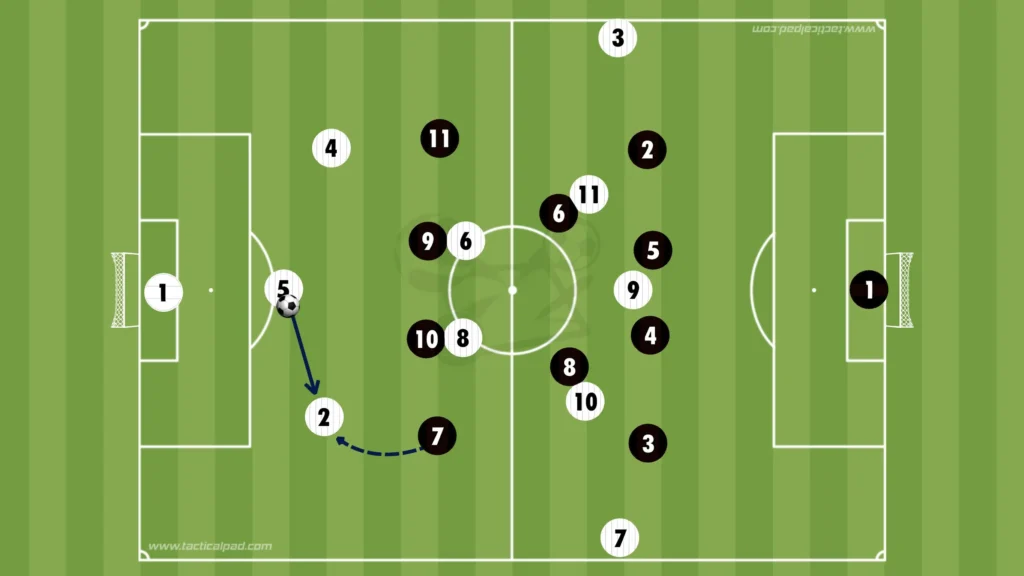
- Strikers’ Role: By staying narrow and keeping the pivots in their cover shadows, the strikers deny the center-backs straightforward central progression.
- Central Center-Back: Often becomes the “outlet” as the wide center-backs run out of options. This is a deliberate concession since the central center-back poses the least danger when advancing the ball.
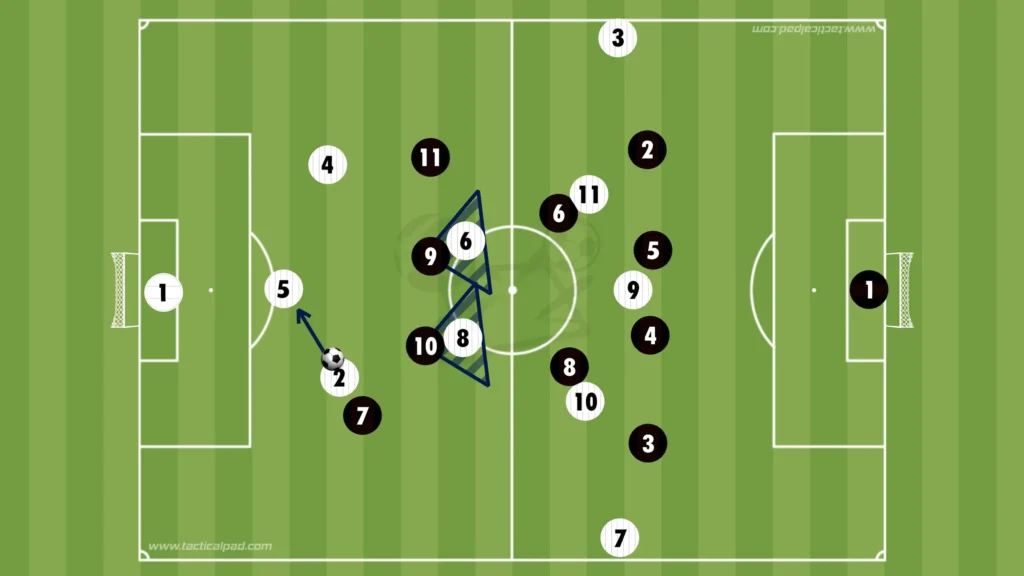
When the ball reaches the central center-back, several coordinated responses are possible:
- The pressing winger continues his run to apply pressure from the side.
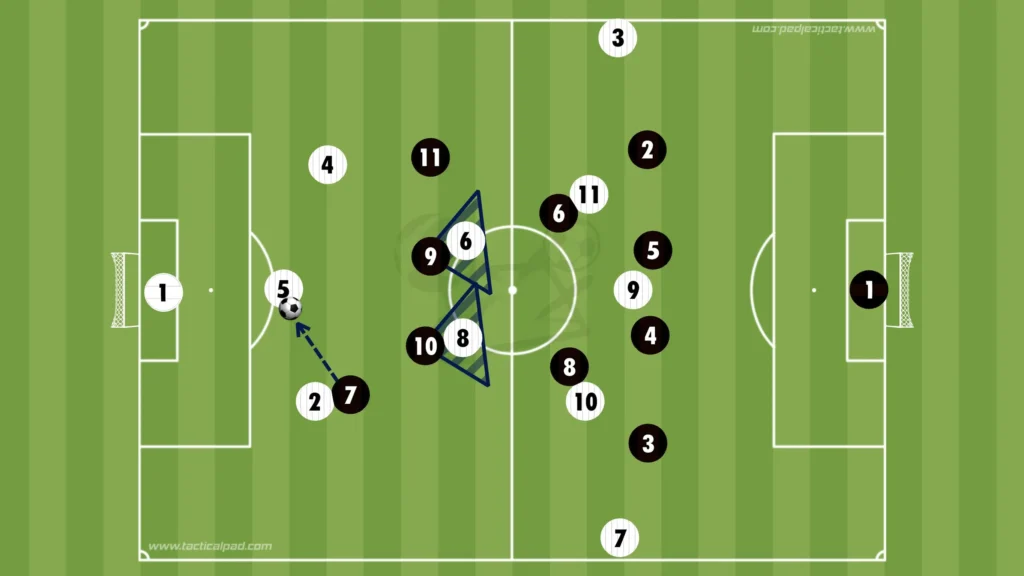
- The opposite winger steps in from the blindside to press.
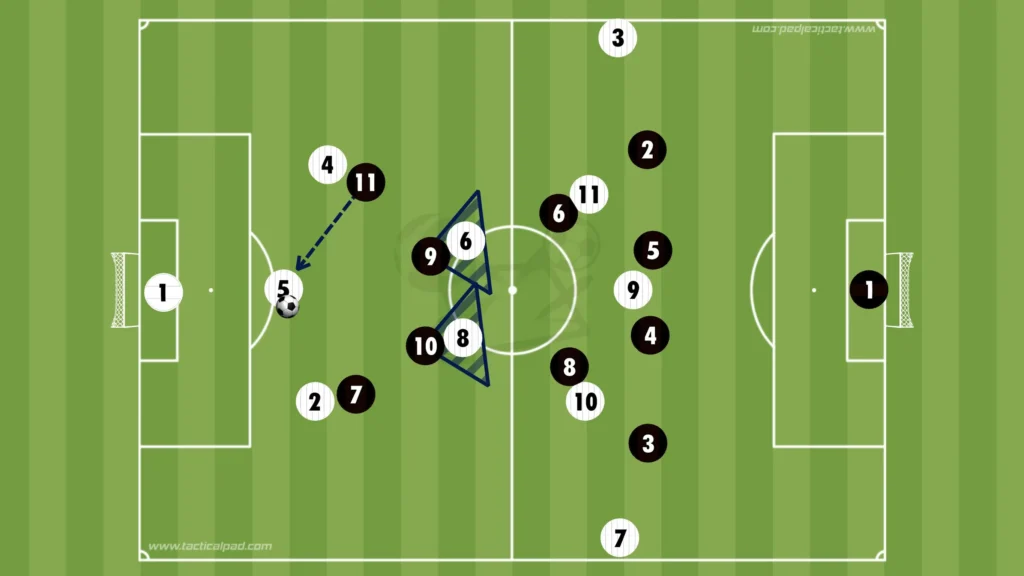
- One striker pushes up while still blocking the nearby pivot.
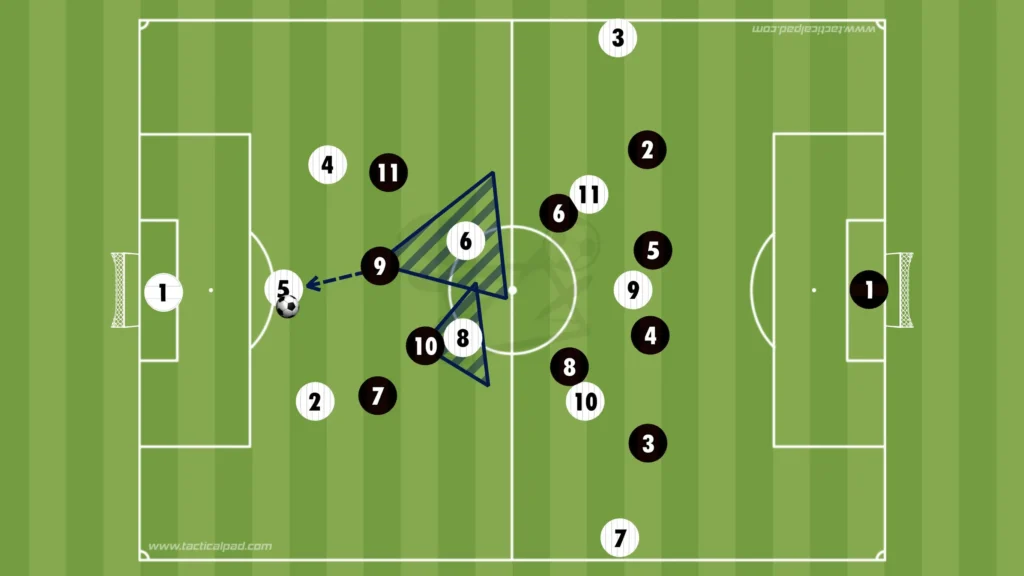
- Or, the team can reset into shape, knowing the central center-back cannot easily penetrate on his own.
Wide Coverage
If the opposition does manage to reach their winger despite the pressing curve, the fullback can step out to engage. Crucially, this does not expose the inside channel, as the holding midfielder is already tracking the attacking midfielder’s underlapping run. This layered coverage allows the defense to remain compact without leaving dangerous gaps.
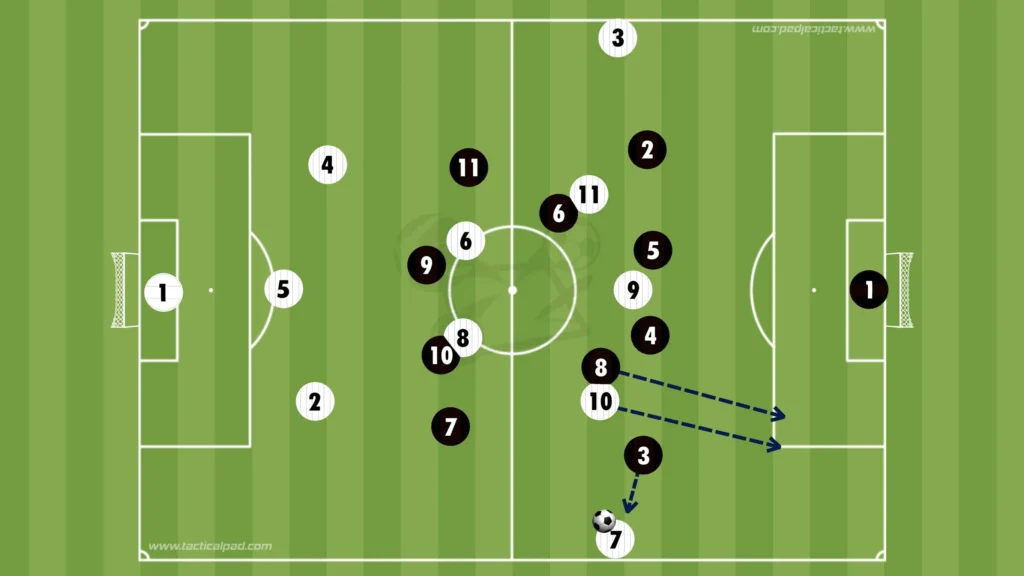
Potential Weaknesses
The 4-2-4 can struggle against:
- Highly fluid 3-2-5 structures with frequent rotations that disorganize the pressing references.
- Ball-carrying center-backs who can dribble past pressing wingers and create overloads in midfield.
- Long diagonal through-balls played quickly into the far winger if the pressing shift is not executed with speed and compactness.
Summary
Despite its vulnerabilities, the 4-2-4 remains one of the most solid and practical ways to defend against the 3-2-5. By forcing play centrally, keeping pivots in cover shadows, and ensuring midfielders protect the channels, it eliminates many of the progression options that make the 3-2-5 so dangerous. It is no coincidence that many top teams adopt this structure when preparing to neutralize the 3-2-5.
Conclusion: Choosing the Right Defensive Strategy Against the 3-2-5
The 3-2-5 is one of the most effective attacking structures in modern football, offering numerical superiority in midfield, width across five lanes, and a strong central presence between the lines. Neutralizing it requires careful consideration of your own squad’s strengths, the opposition’s tendencies, and the game context.
Each defensive shape offers a different set of trade-offs:
- 5-2-3 (Man-to-Man): Provides numerical equality across the pitch but carries high physical and mental demands, with the risk that a single lost duel can collapse the structure.
- 5-3-2 (Compact): Prioritizes central compactness and stability against the front five, but the back three’s spare man can advance if the midfield fails to shift effectively.
- 4-1-4-1: Provides central cover but struggles against wide center-backs and leaves fullbacks exposed in 1v2 scenarios, making it difficult to sustain over 90 minutes.
- 4-2-3-1: Offers stability in the half-spaces through the double pivot, but the constant lateral shifting needed to contain wide center-backs can become exhausting and leave gaps.
- 4-4-2: Strong zonal compactness against rotations but risks leaving players “in-between” opponents, creating dilemmas that high-tempo possession teams can exploit.
- 4-2-4: The most aggressive solution, using wingers to press the wide center-backs and strikers to block pivots. It forces play centrally and limits progression but can be vulnerable to fluid rotations or dribbling center-backs.
Ultimately, there is no “perfect” system to defend against the 3-2-5. Instead, success comes from clarity and cohesion: every player must know their pressing triggers, marking responsibilities, and support rules (such as distance-marking). Teams that defend the 3-2-5 well combine a solid structural choice with the discipline to adjust collectively when the opposition changes their rhythm.
For coaches and analysts, the key takeaway is this: the defensive shape is only the starting point. What matters most is the ability to recognize the 3-2-5’s strengths, anticipate how the opposition intends to exploit them, and train players to respond with coordinated shifts and pressing actions.
